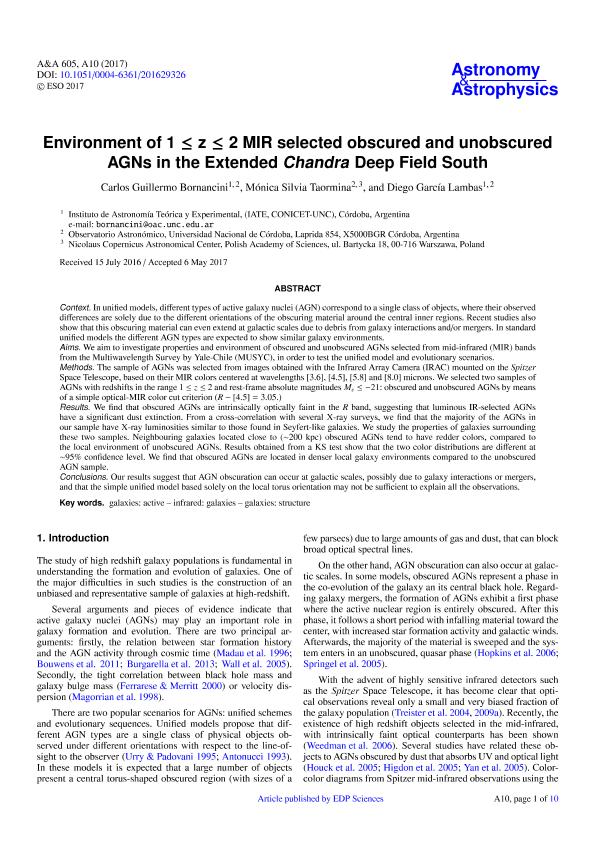Mostrar el registro sencillo del ítem
dc.contributor.author
Bornancini, Carlos Guillermo

dc.contributor.author
Taormina, Mónica Silvia
dc.contributor.author
Garcia Lambas, Diego Rodolfo

dc.date.available
2018-11-02T21:22:54Z
dc.date.issued
2017-09
dc.identifier.citation
Bornancini, Carlos Guillermo; Taormina, Mónica Silvia; Garcia Lambas, Diego Rodolfo; Environment of 1 ≤ z ≤ 2 MIR selected obscured and unobscured AGNs in the Extended Chandra Deep Field South; EDP Sciences; Astronomy and Astrophysics; 605; A10; 9-2017
dc.identifier.issn
0004-6361
dc.identifier.uri
http://hdl.handle.net/11336/63576
dc.description.abstract
Context. In unified models, different types of active galaxy nuclei (AGN) correspond to a single class of objects, where their observed differences are solely due to the different orientations of the obscuring material around the central inner regions. Recent studies also show that this obscuring material can even extend at galactic scales due to debris from galaxy interactions and/or mergers. In standard unified models the different AGN types are expected to show similar galaxy environments. Aims. We aim to investigate properties and environment of obscured and unobscured AGNs selected from mid-infrared (MIR) bands from the Multiwavelength Survey by Yale-Chile (MUSYC), in order to test the unified model and evolutionary scenarios. Methods. The sample of AGNs was selected from images obtained with the Infrared Array Camera (IRAC) mounted on the Spitzer Space Telescope, based on their MIR colors centered at wavelengths [3.6], [4.5], [5.8] and [8.0] microns. We selected two samples of AGNs with redshifts in the range 1 ≤ z ≤ 2 and rest-frame absolute magnitudes Mv ≤ -21: obscured and unobscured AGNs by means of a simple optical-MIR color cut criterion (R - [4:5] = 3:05.) Results. We find that obscured AGNs are intrinsically optically faint in the R band, suggesting that luminous IR-selected AGNs have a significant dust extinction. From a cross-correlation with several X-ray surveys, we find that the majority of the AGNs in our sample have X-ray luminosities similar to those found in Seyfert-like galaxies. We study the properties of galaxies surrounding these two samples. Neighbouring galaxies located close to (~200 kpc) obscured AGNs tend to have redder colors, compared to the local environment of unobscured AGNs. Results obtained from a KS test show that the two color distributions are different at ~95% confidence level. We find that obscured AGNs are located in denser local galaxy environments compared to the unobscured AGN sample. Conclusions. Our results suggest that AGN obscuration can occur at galactic scales, possibly due to galaxy interactions or mergers, and that the simple unified model based solely on the local torus orientation may not be sufficient to explain all the observations.
dc.format
application/pdf
dc.language.iso
eng
dc.publisher
EDP Sciences

dc.rights
info:eu-repo/semantics/openAccess
dc.rights.uri
https://creativecommons.org/licenses/by-nc-sa/2.5/ar/
dc.subject
Galaxies: Active
dc.subject
Galaxies: Structure
dc.subject
Infrared: Galaxies
dc.subject.classification
Astronomía

dc.subject.classification
Ciencias Físicas

dc.subject.classification
CIENCIAS NATURALES Y EXACTAS

dc.title
Environment of 1 ≤ z ≤ 2 MIR selected obscured and unobscured AGNs in the Extended Chandra Deep Field South
dc.type
info:eu-repo/semantics/article
dc.type
info:ar-repo/semantics/artículo
dc.type
info:eu-repo/semantics/publishedVersion
dc.date.updated
2018-10-19T17:37:59Z
dc.journal.volume
605
dc.journal.number
A10
dc.journal.pais
Francia

dc.journal.ciudad
Paris
dc.description.fil
Fil: Bornancini, Carlos Guillermo. Consejo Nacional de Investigaciones Científicas y Técnicas. Centro Científico Tecnológico Conicet - Córdoba. Instituto de Astronomía Teórica y Experimental. Universidad Nacional de Córdoba. Observatorio Astronómico de Córdoba. Instituto de Astronomía Teórica y Experimental; Argentina
dc.description.fil
Fil: Taormina, Mónica Silvia. Polish Academy of Sciences. Nicolaus Copernicus Astronomical Center; Polonia. Universidad Nacional de Cordoba. Observatorio Astronomico de Cordoba; Argentina
dc.description.fil
Fil: Garcia Lambas, Diego Rodolfo. Consejo Nacional de Investigaciones Científicas y Técnicas. Centro Científico Tecnológico Conicet - Córdoba. Instituto de Astronomía Teórica y Experimental. Universidad Nacional de Córdoba. Observatorio Astronómico de Córdoba. Instituto de Astronomía Teórica y Experimental; Argentina
dc.journal.title
Astronomy and Astrophysics

dc.relation.alternativeid
info:eu-repo/semantics/altIdentifier/doi/http://dx.doi.org/10.1051/0004-6361/201629326
dc.relation.alternativeid
info:eu-repo/semantics/altIdentifier/url/https://www.aanda.org/articles/aa/abs/2017/09/aa29326-16/aa29326-16.html
Archivos asociados
